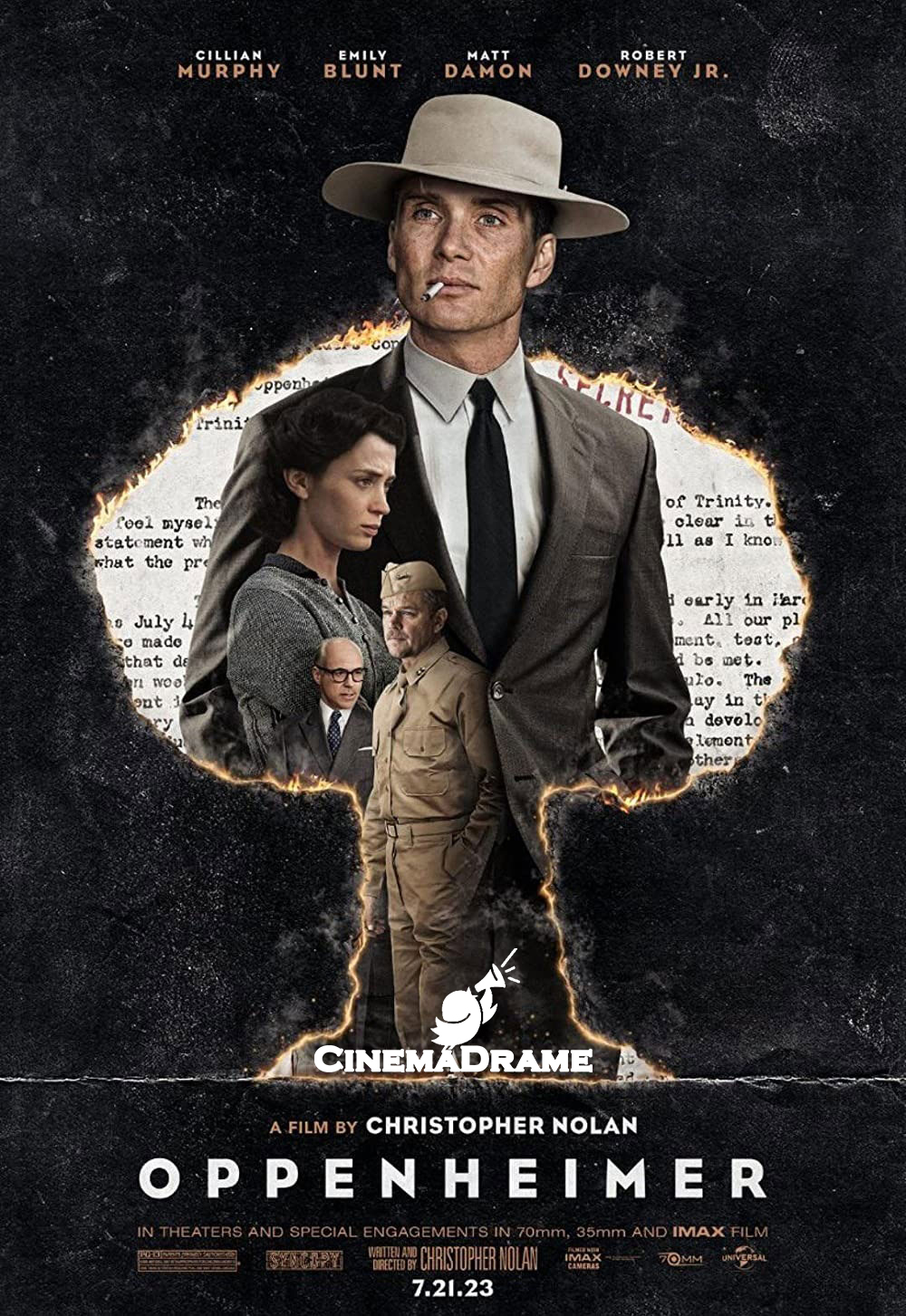Loghman Madayen’s Critique of Christopher Nolan’s Oppenheimer: Nolan, Seeking a World Free of Nuclear Weapons

According to cinemadrame News Agency, Loghman Madayen, a film critic, offered an exclusive review of Oppenheimer, writing: I watched Oppenheimer, a scientific biopic that wasn’t the culmination of the director’s entire effort. When Nolan recommended that audiences watch this film along with its accompanying documentary, I didn’t hesitate. However, the film didn’t offer a more primary narrative than the documentary. Beyond a belief in filmmaking competition, it came to be the suppressed cry of Robert Oppenheimer—reminiscent of French Impressionism. It wasn’t concerned with cinema as much as it was with its mission: that very dialogue at the end of the film, before the Security Clearance Committee’s verdict, where Robert asks his friend if history will ever comprehend the events of this room. The answer is yes. By shining a light on this dark chapter of American history, Nolan attempted to be, in the best possible way, the voice of scientists who were exploited by the world order, and the lament of people who were sacrificed, and those who, in the not-so-distant future, will fall victim to other atomic rivalries.
The film delves into the propaganda that deceived everyone—the fight against Japan. Both in the documentary and the film, it proves that dropping atomic bombs on Hiroshima and Nagasaki was merely to solidify the United States’ authority and test this powerful weapon. Otherwise, Japan had already been subjected to days of heavy American bombing before the atomic attack, the explosive force of which equaled several nuclear weapons, rendering the use of the atomic bomb unnecessary. It depicted the American government’s instrumental use of science and scientists, willing to even exploit the lifeless body of their critic. For instance, after all the pressure on Oppenheimer and the American President’s insult to him, he is honored at the White House to gain media credibility from him. Although in reality, this event occurred during Carter’s presidency, and by then, Oppenheimer’s reputation had somewhat improved, and his efforts to prevent nuclear proliferation were nearing fruition with the agreement of the U.S. and the Soviet Union.
It portrays the power of the media, the fifth pillar of democracy, showing how when news of a fabricated trial leaks, light immediately penetrates the darkness, and truth takes its rightful place.
It exposes American politicians, from Truman himself, who remorsefully sought only the glory of this dirty propaganda, to the Secretary of War who, in choosing cities for bomb impact, selected provinces he hadn’t visited with his family and held no fond memories of.
Ultimately, Nolan once again attempts to alert the world to the danger of nuclear weapons and reignite the fight against them. We saw a manifestation of this vital point in the misanthropic remarks of the Israeli minister who casually stated that Palestinians should be annihilated with atomic weapons once and for all.

Form and Technique Analysis
Let’s move beyond the content, which was undeniably good, and focus on the form and technique.
I’ll start with makeup. We are faced with an incredibly unrealistic Einstein. But is the problem with the makeup? No! The casting was wrong. The makeup artists made an immense effort to recreate the very Albert Einstein for us. Refer to his last biographical photo: from the hair and mustache style to the smile lines, the shape of the nose and chin, the eyes and the lines around them, the forehead, the half-formed eyebrows, and the loose facial muscles—everything is precise, but the overall form doesn’t quite come through. This is less a flaw in the makeup and more a problem with the director who, despite casting an excellent Oppenheimer, failed to supervise other actors. We see the same weakness in the casting of Niels Bohr, although his powerful acting and impressive makeup managed to cover this issue. Nolan created a good Oppenheimer; we beautifully witness his transformation from youth to middle age. Look at the lines around his eyes, the forehead lines; even the shape of his neck changes. We clearly see the aging process in the changing color of his hair and skin. Even his dressing style is consistent and has managed to recreate a very high resemblance, which is commendable. This important aspect is also evident in the makeup and correct casting of Lewis Strauss.
Regarding editing, I will only defend its fast-paced and well-crafted flashbacks. Otherwise, it chose no good beginning; it starts like a documentary, immediately throwing the audience into a pool of information, leaving them to learn to swim alone in its depths. The film lacks proper rhythm and pace; it’s tiring, its pulse isn’t regular, superfluous scenes were not removed, and the scene arrangement is chaotic. What should have been structured as a series over several episodes, they tried to condense into a single video. However, it has good color correction and lighting; color contrasts are observed; sound and image are synced; the ambiance between sound and silence is maintained; it has good effects but fails to emotionally engage the audience. The director’s intention is not reinforced, the atmosphere is not impactful, it’s an assembly of arbitrary cuts that provide no new information, we don’t find continuity in the action of each shot, and in a nutshell, I must say that after the directing, it is the editing that has dealt a serious blow to the film.
We criticize the director for two initial weaknesses before delving into other aspects. Firstly, he didn’t hammer out the screenplay. Secondly, he didn’t supervise the editing. We don’t even see a precise image of the atomic mushroom cloud; instead, he clearly falls prey to the French Impressionism style, meaning he tried to delve into Oppenheimer’s mind. We see the protagonist going through a series of events to show his emotions, to manifest his introversion; even the flashbacks serve this style to delve into his mind. We see a character who committed suicide, and from the middle of the film onwards, we witness the fast-paced editing derived from the style of Abel Gance and Jean Epstein. But what about the first half? That slow and tiresome rhythm is a serious bug. Even in the framing, he tried to show the character’s inner state, pulling the camera out of focus, blurring images, imposing naturalism on the actors to reveal emotions and excitements at their peak. Yet, in the action, he didn’t give the viewer enough time to reflect on the characters’ reactions and emotional states, and characterizations are not well-formed. He paid no serious attention to mise-en-scène, contenting himself with striking and real locations for impact. He disregarded color psychology, focusing more on color palettes, and all this means he was unsuccessful in transitioning to Impressionism, just as he was unsuccessful in his attempt to cover his recurring weaknesses with a few erotic shots.
His camera angles were excellent, such as when he depicted Einstein in a long shot for introduction, or when he showed Oppenheimer in the witness hearing from a high-to-low angle, hunched over, head in his hands, nervous, symbolizing his weakness and vulnerability. Or when Strauss realized his defeat in court and lost the Secretary of Commerce position, or when, after Strauss’s official defeat, he showed Oppenheimer from a low-to-high angle in the courtyard to demonstrate his position of power.
Nolan is so influenced by Cillian Murphy that in the scene of scientists being prohibited from leaving Los Alamos and Teller’s sulking while researching the hydrogen bomb, he draws inspiration from Peaky Blinders, doing a complete 360-degree pan to each scientist along a 180-degree imaginary line, pointing his finger at each and giving them an independent mission.
The anti-value was Oppenheimer, who, contrary to Niels Bohr and Einstein’s advice, proceeded with the creation of the atomic bomb. But when he realized its true power, he tried to prevent its proliferation, and here he transformed into a value.
The connecting element was the atomic bomb, which linked the fate of the world.
The hero was Oppenheimer, who overcame obstacles and triumphed in the atomic race against Germany and the Soviet Union, brought Japan to its knees, and ultimately overcame Strauss, who was the film’s antagonist.
I consider the first inciting incident to be where Oppenheimer tells the lab official, “I know what you’re doing, and I don’t need special security access; I approve of your work,” at which point Lawrence welcomes Oppenheimer, and the challenge begins.
I mark the climax as the moment Dr. Hill, in court, exposed the Security Clearance Committee’s misconduct and unveiled Strauss’s behind-the-scenes actions against Oppenheimer. At this moment, truths were revealed.
The second turning point was when the Security Clearance Committee, in its final verdict, declared Oppenheimer a loyal citizen, and at that very moment, the result of his efforts for the court was confirmed, and he found peace. We recall that Einstein had told him the government exploited him, so he should turn his back on them. Oppenheimer, in response, declared, “I love this country, and I will not turn my back on it.”
The characterizations didn’t turn out well; it’s so cluttered that the film itself is forced to keep the audience alert with continuous flashbacks. The proliferation of characters means that the characterizations lack depth.
We have many good moments of suspense, provided you haven’t watched the documentary before the film, contrary to Nolan’s recommendation. For example, when he tries to poison his professor, or when we assume he had an argument with Einstein, or when he realizes the true power of the atomic weapon and tries to counteract it, or the moment he hands the bomb over to the government and is suddenly discarded like a used rag, with even the president humiliating him, or where he comes within an inch of defeat in court but is saved.
Nolan’s symbolism is very precise. From the very beginning, drawing inspiration from a true narrative, he introduces an apple that Oppenheimer tries to poison and murder his professor with by injecting cyanide. The apple here symbolizes knowledge, the same apple that led to the discovery of gravity. So, with a slight distortion of reality, it symbolizes Oppenheimer’s actions, who, by discovering the atomic bomb, tries to make knowledge, which should be beneficial, poisonous and deadly.
But it doesn’t end there. Let’s move to after the atomic weapon test, when they held a victory celebration, and Oppenheimer enters the hall to give a speech, and his vision blurs. The camera angle makes it seem as if people’s eyes in a church are fixed on the statue of the Holy Trinity of Jesus. It aims to say that Oppenheimer, like Christ, carries the burden of others’ sins. Like Jesus, he gathers his disciples, and like him, one of his companions betrays him and he is crucified. But Nolan’s interpretation here is not accurate, because in this instance, Oppenheimer bears the burden of his own sins more than anyone else’s.
The story’s timeline is not observed, and this is a serious problem. That is, the scenes shown sometimes have years of time difference from other narratives, such as when Oppenheimer builds the bomb and the Security Clearance Committee meetings are held, but the trial session where Dr. Hill exposes Strauss happens years later, not concurrently! And the audience only grasps a fraction of what actually occurred, which is a major weakness, forcing the viewer to read several books and watch documentaries to understand a film.
Another point is the name of the nuclear weapon test operation, which Nolan named Trinity, meaning the Holy Trinity (Father, Son, Holy Spirit). In fact, with this naming, he had two goals: first, to say that when all scientists come together, they can transform the world in this way, and second, that just as the world entered a new era after Christ’s crucifixion, so too will the world enter a new era after the testing of this weapon.
Another point is that during the victory speech, when Oppenheimer’s emotional state deteriorates and he sees images blurred, a girl in front of him appears to be melting, and skin peels from her face. That is Nolan’s own daughter, and the director intended to convey that when someone creates such a dangerous weapon, they should first imagine it being tested on their own family.
Another point is the contrast between color and black-and-white images. In color images, we see everything from Oppenheimer’s mind, and this is why in Heisenberg’s class, when the camera is on him, his language is German, and when the camera returns to Oppenheimer, the language becomes English—meaning the simultaneous translation of words takes place in Oppenheimer’s mind. This is why Oppenheimer and Einstein’s meeting at the end of the film, which is in color, is accompanied by laughter and cheerfulness, but at the beginning, which is black and white, it is bitter and sad. This is because the black-and-white images are from Strauss’s perspective, who views Oppenheimer as arrogant and self-centered and looks at him from a negative angle. Nolan drew inspiration for this color and black-and-white perspective from the cover of Time magazine, which one day printed Oppenheimer’s image in color in his praise, and another day in black and white in his criticism.







